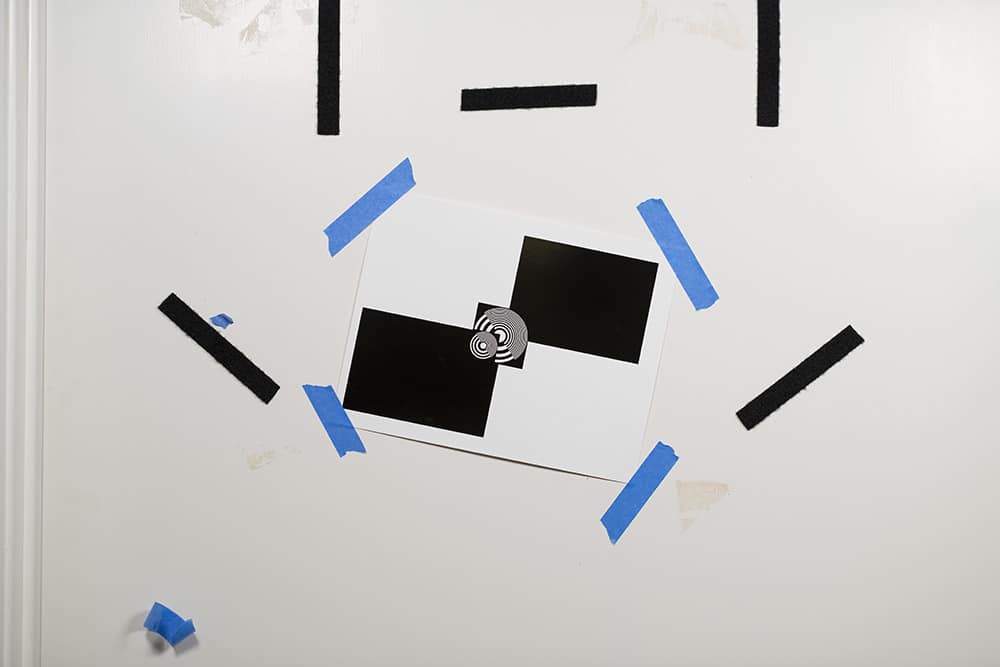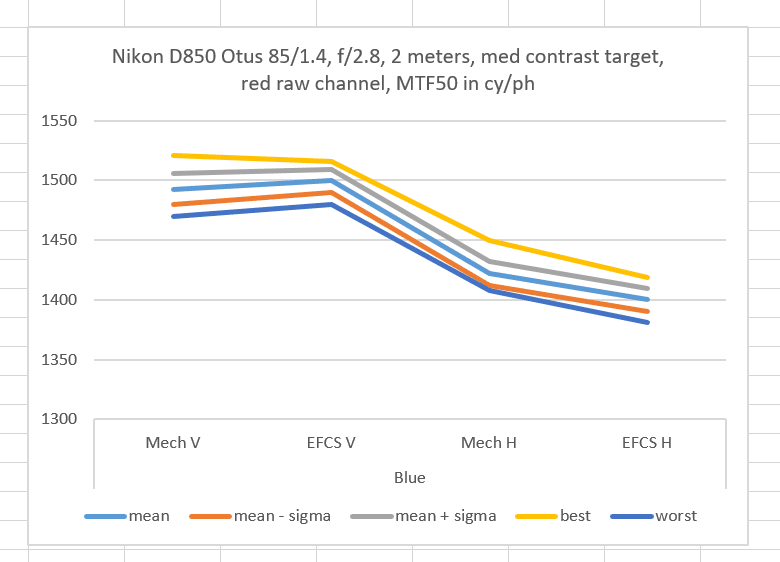This is the 20th post in a series of Nikon D850 tests. The series starts here.
There have been a few — very few — complaints about the D850 shutter shock. The camera has lots of ways to deal with that problem if it’s objectionable, but I wanted to see how bad it could be if you didn’t employ any of those. I did mount the camera securely for the test:
- Gitzo Systematic Series 5 three-section legs
- Cognisys rail
- Arca Swiss C1 Cube
I also didn’t use a super long lens, only 85 mm. But I did pick a very sharp one, the Otus 85 mm f/1.4, and I used it at its sharpest aperture, f/2.8. I also used a moderately sharp inkjet printed target backlit with a pair of Westcott LED panels bounced off a white diffuser. ISO was 64, shutter speed 1/200 second. That’s roughly the worst shutter speed for shutter shock on the Sony a7R with this lens and roughly the same mounting arrangement.
I could have used a camera stand instead of a tripod for even more stability, but I thought that most folks would not use the D850 that way.
I focused the lens on the for each of the two runs, one using the live view and the D850’s mechanical shutter, which requires winding the shutter just before each exposure, and one using the electronic shutter, which introduces no vibration at all. I used maximum magnification, peaking, and a Hoodman loupe.
Here’s how the target appeared to the camera:
I focused once and made 32 exposures 3 seconds apart using a Nikon intervalometer, all in live view, first with the mechanical shutter, and then with EFCS.
I’ll just report the blue channel results since they are the best; I must have misfocused a bit.
The vertical axis is the MTF50 in cycles per picture height. I’ve plotted the worst, average (aka mean), and best results, and also the mean plus and minus the standard deviation (aka sigma). The points labeled V are for a vertical edge, and the ones labeled H are for a horizontal one. The difference between the V and H MTF50s is not important, and probably is mostly related to target alignment and how far off-axis the regions of interest were.
I don’t consider the differences significant. I think that EFCS is optional with moderate telephotos and shorter lenses and a good solid mounting arrangement. But why would you not use it?
I will report on other shutter modes shortly.


Thank you !
Also thanks.
Jim >> I could have used a camera stand instead of a tripod for even more stability, but I thought that most folks would not use the D850 that way.
I’m curious what the difference is between a “camera stand” and a “camera tripod”?
Is the camera stand without the head with a 1/4″ thread to secure the camera? Like a light stand or microphone stand?
Here’s a nice beefy camera stand:
https://www.bhphotovideo.com/c/product/1127927-REG/foba_f_asaba_r_studio_stand_2_5m_rotating.html
Good to see. I suppose Nikon learned a valuable lesson for the whole industry with the D800. The focus shift on the red channel is odd. Thermal expansion in the lens perhaps? Or on the rail? Tripod? Hmm, no, 2mm shift would be too much for thermals on the support. Just thinking out loud.
Nice, the camera really does tick every box, but why would red be more prone to shutter shock that makes no sense. Also it not clear whether the electronic first curtain was used. Any chance you could do worst case with mirror slap?
Shouldn’t you have used a horizontal edge?
I’d expect the mostly vertical edge to be less affected by movement of the shutter.
Good point. I’ve noticed that tripod-mounted shake is often worse for vertical edges even with a vertical forcing function. If I’d had an L-bracket for the D850, I’d have turned the camera 90 degrees and used the vertical edge.
Great test Jim. Here’s a quick check I did which included a mirror-slap sample:
https://photos.smugmug.com/photos/i-6TGsKMb/0/5b249384/O/i-6TGsKMb.jpg
Here is a legend of the 5 images in the above composite image, from top to bottom:
1) In VF shooting mode. Purpose: Measure full vibration of camera, ie both mirror and shutter
2) In VF shooting mode, MUP achieved via exposure delay. Purpose: Measure shutter vibration
3) In VF shooting mode, EFCS via MUP+exposure delay. Purpose: Measure only 2nd curtain shutter vibration
4) In LV shooting mode, silent mode 1 (electronic)+timer. Purpose: Absolute best-case scenario vibration
5) In LV shooting mode, regular mode+timer. Purpose: Measure shutter cycling vibration